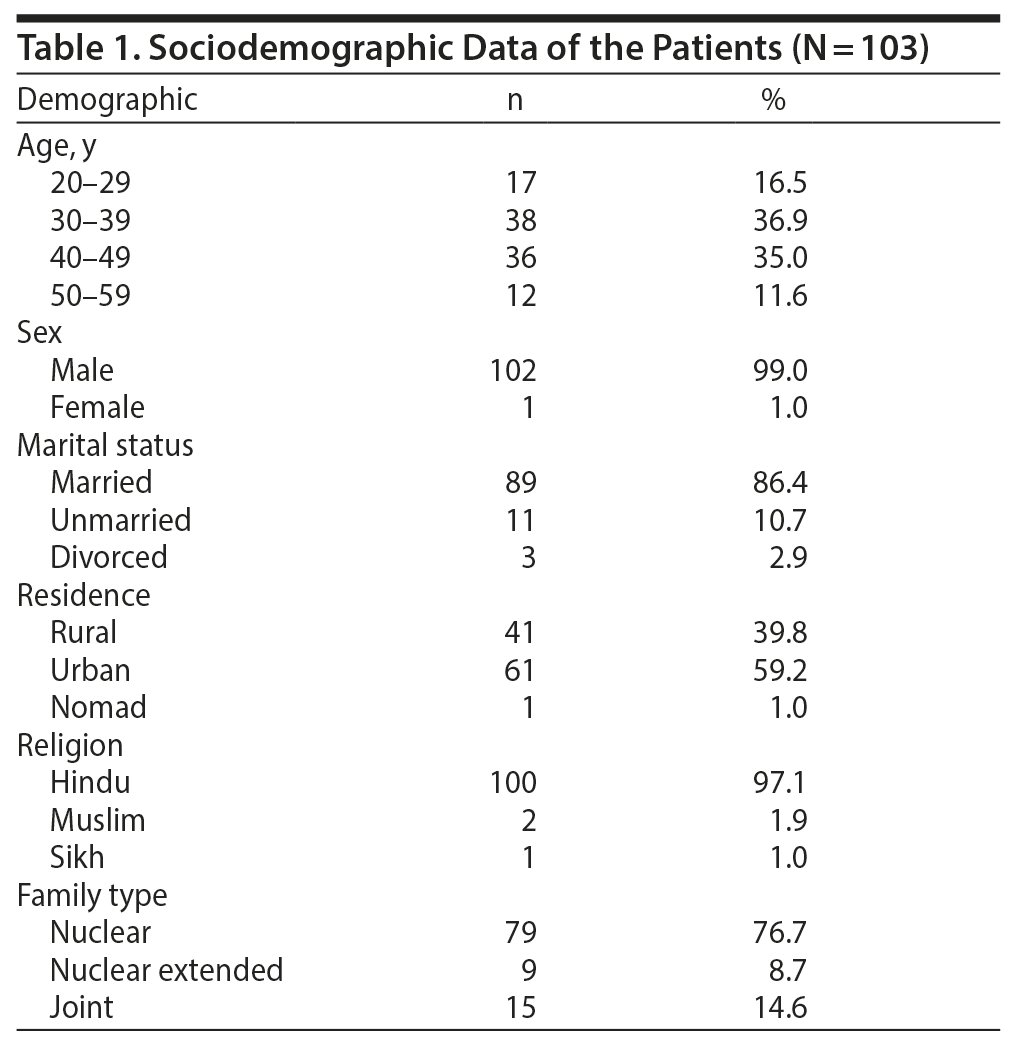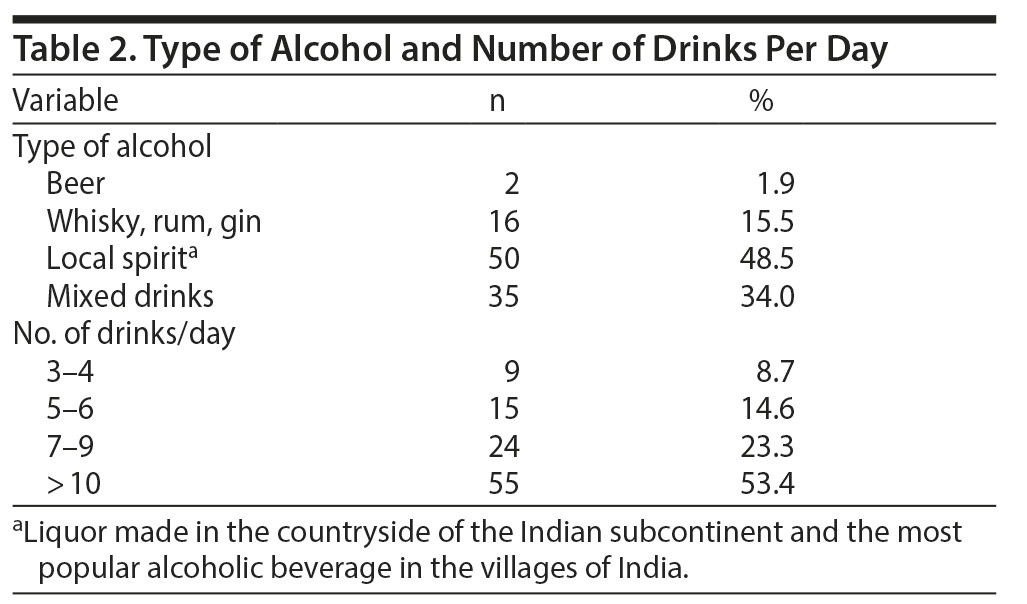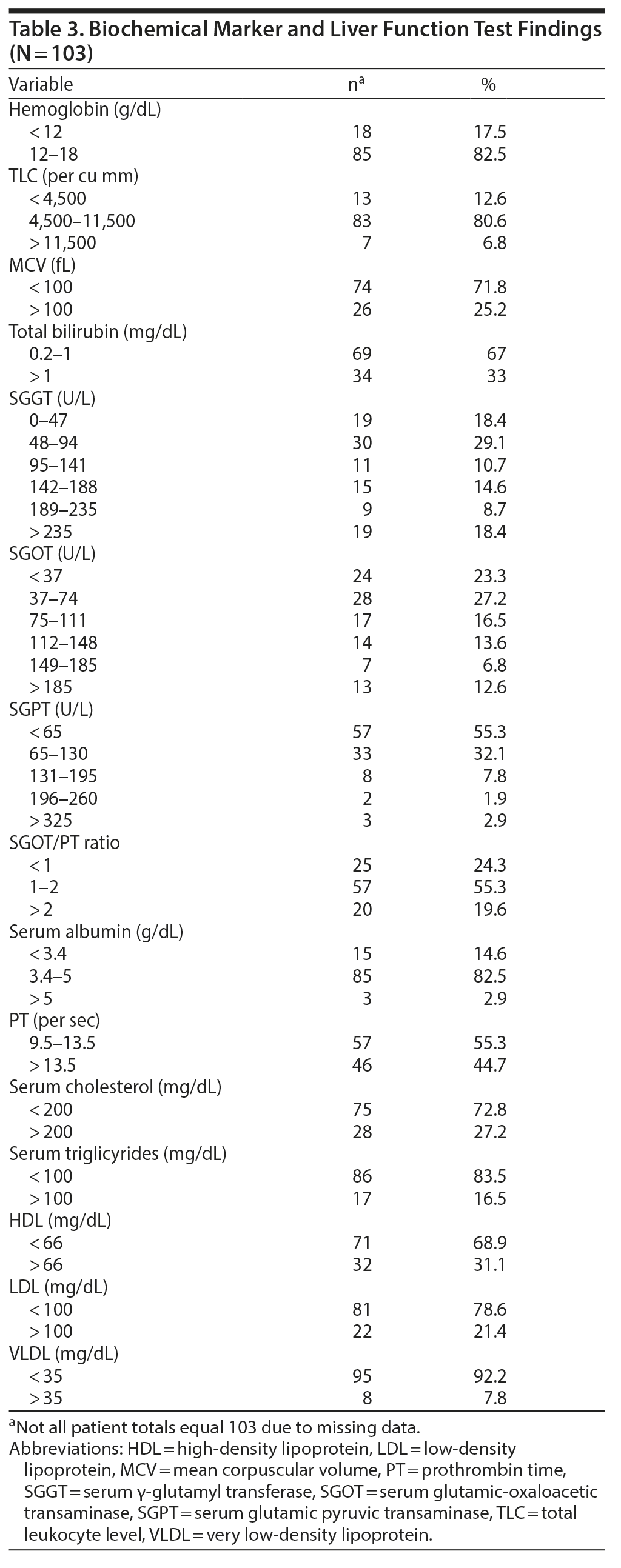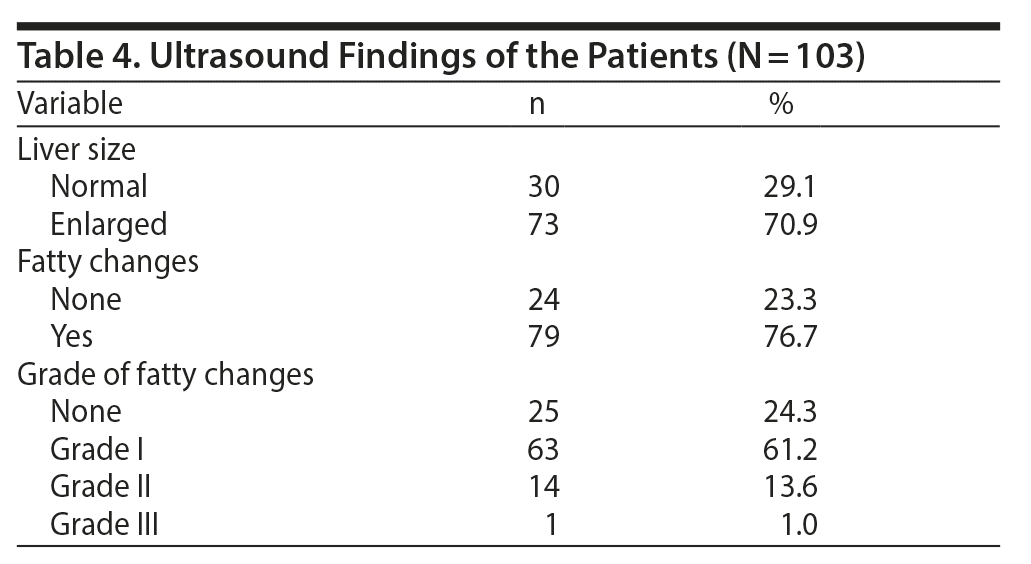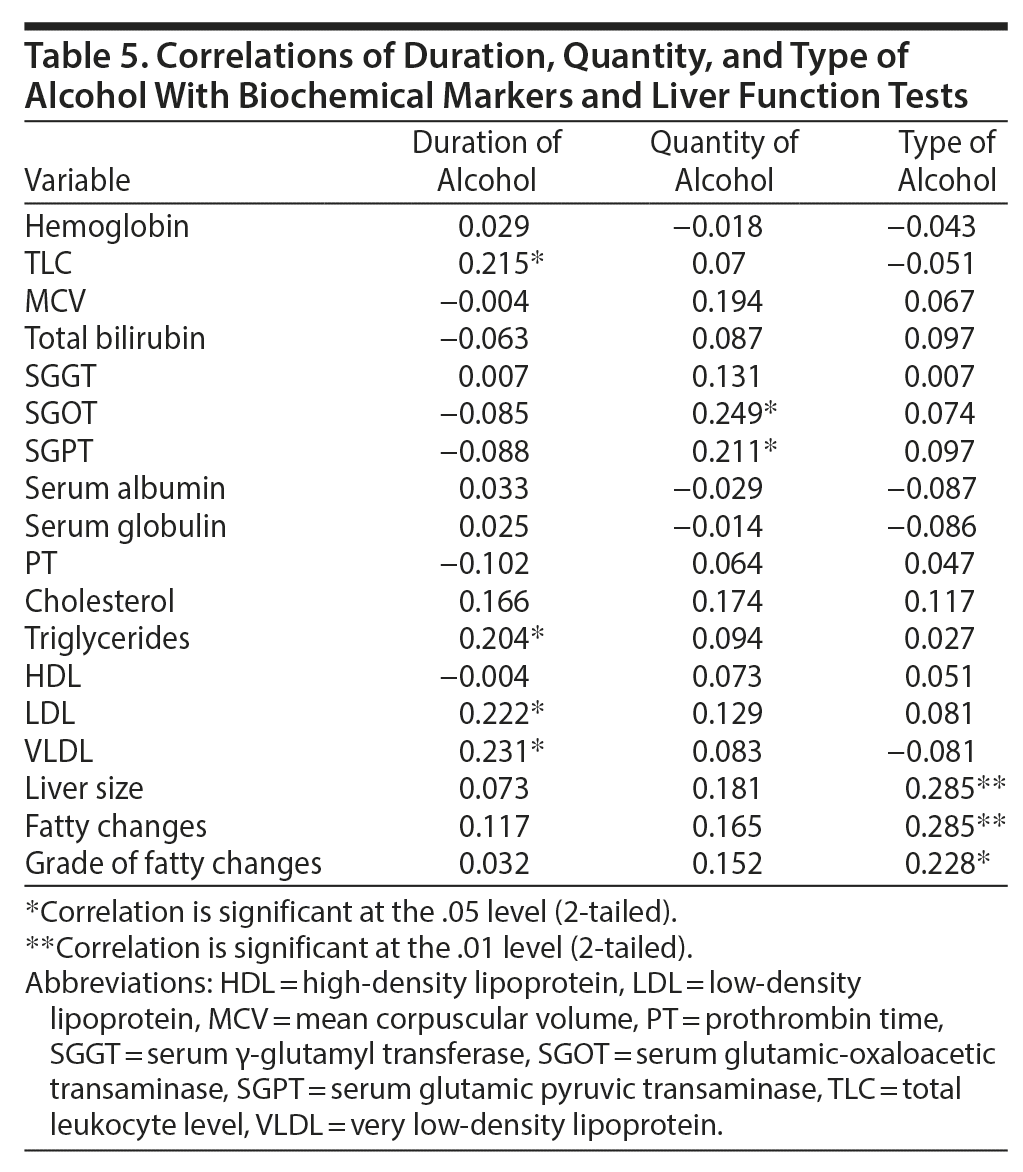Objective: To study the correlation of type, quantity, and duration of alcohol consumption with biochemical markers and liver function tests.
Methods: The study included 103 patients with a history of alcohol use presenting to the psychiatry department of a hospital in India from March 1, 2017, to February 28, 2018. A self-administered structured questionnaire was used to assess demographics and clinical characteristics. Biochemical markers and laboratory tests included hemoglobin, total leukocyte count, mean corpuscular volume, liver function, and lipid profile. Liver ultrasonography was also conducted. Patients completed the Alcohol Use Disorders Identification Test to assess excessive alcohol use.
Results: Of the patients, 17.5% had a hemoglobin level < 12 g/dL. The mean total leukocyte count was 7.292 per cu mm, and a significant (P = .05) correlation was observed with duration of alcohol consumption; 26% had a mean corpuscular volume > 100 fL. One-third (33%) of the patients had total bilirubin values > 1 mg/dL. The majority (81.6%) had a γ-glutamyl transferase level > 47 U/L, and 19.4% had a serum glutamic-oxaloacetic transaminase/pyruvic transaminase ratio > 2. Liver size was increased in 71% of the patients.
Conclusion: There was a significant correlation (P = .05) between type and quantity of alcohol and liver function tests, signifying poor quality of alcohol (ie, many patients drank "local spirit" alcohol, which is liquor made in the countryside of the Indian subcontinent) and that higher alcohol consumption caused more damage to the liver. The positive correlation between duration and lipid derangement signifies that longer duration of alcohol consumption leads to more lipid profile abnormalities, which in turn causes liver injury. Early detection of liver injury with these investigations, keeping in mind the quantity, type, and duration of alcohol consumption, will help in primary and secondary prevention of alcohol-induced disorders.
Correlation of Type, Quantity, and Duration of Alcohol Consumption With Biochemical Markers and Liver Function Tests
ABSTRACT
Objective: To study the correlation of type, quantity, and duration of alcohol consumption with biochemical markers and liver function tests.
Methods: The study included 103 patients with a history of alcohol use presenting to the psychiatry department of a hospital in India from March 1, 2017, to February 28, 2018. A self-administered structured questionnaire was used to assess demographics and clinical characteristics. Biochemical markers and laboratory tests included hemoglobin, total leukocyte count, mean corpuscular volume, liver function, and lipid profile. Liver ultrasonography was also conducted. Patients completed the Alcohol Use Disorders Identification Test to assess excessive alcohol use.
Results: Of the patients, 17.5% had a hemoglobin level < 12 g/dL. The mean total leukocyte count was 7.292 per cu mm, and a significant (P = .05) correlation was observed with duration of alcohol consumption; 26% had a mean corpuscular volume > 100 fL. One-third (33%) of the patients had total bilirubin values > 1 mg/dL. The majority (81.6%) had a γ-glutamyl transferase level > 47 U/L, and 19.4% had a serum glutamic-oxaloacetic transaminase/pyruvic transaminase ratio > 2. Liver size was increased in 71% of the patients.
Conclusion: There was a significant correlation (P = .05) between type and quantity of alcohol and liver function tests, signifying poor quality of alcohol (ie, many patients drank "local spirit" alcohol, which is liquor made in the countryside of the Indian subcontinent) and that higher alcohol consumption caused more damage to the liver. The positive correlation between duration and lipid derangement signifies that longer duration of alcohol consumption leads to more lipid profile abnormalities, which in turn causes liver injury. Early detection of liver injury with these investigations, keeping in mind the quantity, type, and duration of alcohol consumption, will help in primary and secondary prevention of alcohol-induced disorders.
Prim Care Companion CNS Disord 2020;22(3):19m02439
To cite: Kherada S, Sharma S, Gocher S, et al. Correlation of type, quantity, and duration of alcohol consumption with biochemical markers and liver function tests. Prim Care Companion CNS Disord. 2020;22(3):19m02439.
To share: https://doi.org/10.4088/PCC.19m02439
© Copyright 2020 Physicians Postgraduate Press, Inc.
aDepartment of Psychiatry, Ravindra Nath Tagore Medical College, Udaipur, Rajasthan, India
*Corresponding author: Sunil Sharma, MD, Department of Psychiatry, Ravindra Nath Tagore Medical College, Udaipur, Rajasthan, India PIN-313001 ([email protected]).
Alcohol consumption above safe limits is a serious health issue with major socioeconomic consequences. Clinicians are likely to identify only 20%-50% of patients with alcoholism who present for medical care.1
The diagnosis of alcohol use disorder is often based on the patient’s self-reporting of alcohol consumption, which is notoriously unreliable2 and must be reviewed with a high degree of clinical suspicion. The clinical symptoms and findings of alcohol-related damage frequently mimic other diseases. Many heavy drinkers are in good health, with no visible ill effects from their excessive drinking, and are unlikely to seek medical advice. Some individuals can proficiently hide their alcohol addiction, and by the time these patients present for a consultation, it is often too late to reverse either the organ damage or the alcohol dependence. However, if alcohol problems are identified at an early stage, a clinician may be able to stop further development and progression.3
The safe limits for alcohol intake are disputable, as there is a considerable difference in individual susceptibility to alcohol-related damage. Guidelines of the Royal College of Physicians4 advise a weekly limit of 21 units (168 g) of alcohol for men and 14 units (112 g) for women. These limits have also been recommended by the Royal Colleges of Psychiatrists and General Practitioners.5
The liver metabolizes alcohol and thus is most affected by alcohol abuse. Alcohol-related liver disease can progress through the stages of steatosis, inflammation, necrosis, fibrosis, and cirrhosis, leading to fatty liver, alcoholic hepatitis, cirrhosis of the liver, and, rarely, hepatocellular carcinoma.6
The liver carries out functions such as storage, synthesis, and detoxification. Biochemical tests are available to assess liver function. Derangements in liver function tests are found in the diseased state and also may be seen in the context of alcohol consumption.7
There are advantages and limitations of traditional and new markers of alcohol abuse (and abstinence) for detection and monitoring of alcoholic patients, hazardous drinkers, and binge drinkers. Traditional markers include γ-glutamyl transferase (GGT), aspartate aminotransaminase (AST), alanine aminotransaminase, and mean corpuscular volume (MCV). More recent markers include mitochondrial AST, carbohydrate-deficient transferrin, serum/urine 5-hydroxytryptophol, and β-hexosaminidase and acetaldehyde adducts. This study aimed to quantitatively assess the type, duration, and amount of alcohol consumed and the association with biochemical markers and liver function tests.
METHOD
This cross-sectional observational study was conducted in the Department of Psychiatry at Maharana Bhupal Govt Hospital and Rabindranath Tagore Medical College, Udaipur, India, from March 1, 2017, to February 28, 2018. Subjects included all consecutive patients admitted to the psychiatry department with a history of alcohol consumption of a duration ≥ 1 year. Subjects were aged 18 to 60 years with a history of drinking a minimum of 16 g of alcohol/day or 2 units (drinks)/day. Patients with nonalcoholic liver disease, recent history of taking hepatotoxic drugs, or recent history of malaria, dengue fever, viral hepatitis, or septicemia and patients diagnosed with congestive heart failure, right-sided heart failure, or other causes of congestive/ischemic hepatitis were excluded from the study.

- Alcohol consumption causes a variable degree of liver damage, which can be estimated with biochemical markers, liver function tests, and ultrasonography.
- Early detection of alcohol-related liver damage, keeping in mind the quantity, type, and duration of alcohol consumption, will aid in the preventive care and treatment of patients with alcohol use disorder.
- Biomarkers for liver damage should be evaluated in all patients with alcohol use disorder, irrespective of level of use, and should be mandatory in those who drink > 10 drinks/day.
Study Instruments
Self-administered questionnaire. This structured form included demographics and basic questions regarding the patient’s complaints, medical history, and history of alcohol and other substance use, including frequency and abstinence.
The Alcohol Use Disorders Identification Test. The Alcohol Use Disorders Identification Test (AUDIT)8 is a 10-item screening tool developed by the World Health Organization to assess alcohol consumption, drinking behaviors, and alcohol-related problems. The clinician-administered version was used in this study. Patients were encouraged to answer the AUDIT questions in terms of standard drinks. A chart illustrating the approximate number of standard drinks for different alcoholic beverages was included for reference. A score ≥ 8 is considered to indicate hazardous or harmful alcohol use.
Biochemical Markers and Liver Function Tests
Laboratory tests included hemoglobin (Hb), total leukocyte count (TLC), and MCV; liver function tests (serum glutamic-oxaloacetic transaminase [SGOT], serum glutamic pyruvic transaminase [SGPT], serum GGT [SGGT], bilirubin, serum albumin, globulin, and prothrombin time [PT]); and lipid profile (triglycerides, low density-lipoprotein [LDL], high-density lipoprotein [HDL], very low-density lipoprotein [VLDL]). Liver ultrasonography was also performed. Tests were conducted at the central laboratory of a tertiary care hospital operated by the hospital’s biochemistry department using standard protocols. Ultrasonography was conducted by radiology consultants. Samples of blood were collected within 24 hours of admission.
Ethical Issues
The participants were assured confidentiality, and informed consent was taken. The purpose of the study was clearly explained, and blood samples were taken on a voluntary basis.
Data Analysis
The collected data were analyzed using descriptive and inferential statistics with SPSS version 19 (IBM Corp, Armonk, New York).
RESULTS
A total of 103 patients were included in the study. Table 1 provides the sociodemographic details of the study participants. Half of the participants (48.5%) drank local spirit alcohol (liquor made in the countryside of the Indian subcontinent and the most popular alcoholic beverage in the villages of India), and 53.4% were heavy drinkers (> 10 drinks/day) (Table 2).
Biochemical marker and liver function test data of the patients are presented in Table 3. The mean (SD) Hb level was 13.35 (2.16) g/dL, and only a few participants (17.5%) had a level < 12 g/dL. Most of the patients (80.6) had TLC levels within the normal range of 4,500-11,500/cu mm, and more than one-quarter (25.2%) had a mean MCV > 100 fL. Similarly one-third (33.0%) of patients had a mean total bilirubin level > 1 mg/dL.
A high percentage of participants (81.6%) had an SGGT level > 47 U/L; 18.4% had an SGGT level more than 5 times the normal value (> 235 U/L). Three-fourths of patients (76.7%) had a mean SGOT value > 37 U/L, and one-tenth (12.6%) had a level more than 3 times the normal value (> 185 U/L). Similarly, nearly half (44.7%) had a SGPT value above the normal level (< 65 U/L), and 12.6% had levels 2 times greater than normal. An SGOT/PT ratio > 2 was found in 19.6% of participants; 55% had a ratio of 1:2.
The mean ± SD albumin level was 3.91 ± 0.68 g/dL; 14.6% of participants had a level < 3.4 g/dL. The mean (SD) PT value was 13.54 (1.4)/second, ranging from 10.4 to 18.8/second. Nearly half of the participants (44.7%) had a PT level > 13.5/second.
Serum cholesterol was elevated above 200 mg/dL in 27.2% of patients and serum triglycerides above 100 mg/dL in 16.5%. HDL levels were below 66 mg/dL in more than two-thirds (68.9%) of participants. The mean (SD) LDL value was 73.25 (37.6) mg/dL, ranging from 7 to 180 mg/dL; 21.4% had an LDL level > 100 mg/dL. Similarly, the mean (SD) VLDL value was 23.94 mg/dL (0.02), ranging from 8 to 83 mg/dL.
Ultrasound findings in Table 4 show that almost one-third (70.9%) of participants had an enlarged liver and more than three-fourths (76.7%) had fatty changes. Of these patients, 61.2% had grade I, 13.6% had grade II, and 1% had grade III fatty changes, and 2.9% had cirrhotic changes in the liver.
Table 5 shows a correlation of alcohol type, quantity, and duration of consumption with the biochemical markers and liver function tests. A significant positive correlation was found between TLC, triglyceride, LDL, and VLDL levels and duration of alcohol consumption, and only SGOT and SGPT levels had a significant positive correlation with the quantity of alcohol. Liver ultrasound findings were most influenced by type of alcohol consumed. A significant correlation was found between liver size and fatty changes and their grades and type of alcohol consumed.
DISCUSSION
The present study assessed the correlation of alcohol consumption variables with biochemical markers including liver function tests. We found that local spirits were consumed by 48.5% of participants, mixed drinks by 34.0%, and branded whisky, rum, or gin by 15.5%. Nand et al9 also observed a similar pattern. In their study,9 53.4% of participants drank > 10 drinks/day, which is close to the findings of a study by Walter and Ashraf,7 who found that 44% patients were drinking > 9 drinks/day.
In our study, Hb levels < 12 g/dL were found in 17.5% of participants and leukocytosis in 6.8%; however, Nand et al9 found that 87% of patients with alcohol consumption (≥ 16 g or 2 units/d) had anemia and 36% had leukocytosis. The difference might be due to severity of symptoms, duration of consumption of alcohol, and patient profiles.
We found that 33% of participants had a serum bilirubin level > 1 mg/dL. Hyperbilirubinemia was observed by Walter and Ashraf7 in 40% of patients and by Nand et al9 in 85% of patients. Other studies10-12 also reported varying prevalence of hyperbilirubinemia with alcohol use. Walter and Ashraf7 found a statistically significant correlation between quantity and duration of alcohol with serum bilirubin level, which we did not observe in our study. However, Nand et al9 found no correlation between bilirubin and type, amount, or duration of alcohol consumption.
In our study, the SGOT/SGPT ratio was < 1 in 24.5 of participants, which is similar to findings of an older study13 that found small differences for ratio 1-2 (55.9%) and ratio > 2 (19.6%).
In our study, the mean ± SD SGOT/SGPT ratio was 1.53 ± 0.91 U/L, and this finding is lower than that of other studies.9 Nyblom et al13 suggested that high SGOT/SGPT ratios in alcoholic liver disease were mainly found in patients with advanced disease. The present study also showed a positive correlation between SGPT and quantity of alcohol, similar to Walter and Ashraf7 who noted a significant positive correlation of SGPT, PT, and bilirubin with quantity of alcohol (0.38 and 0.354, respectively, r = 0.44). In our study, GGT was elevated (mean = 246 U/L) and was > 47 U/L in 81% of the patients. This finding is similar to previous studies14,15 that also reported higher values.
The mean ± SD serum albumin level was 3.91 ± 0.68 g/dL, and 19.4% of participants had an albumin level < 3.40 g/dL. A negative nonsignificant correlation of serum albumin level with quantity and type of alcohol was found. Other studies9,11 also reported no significant correlation, with the exception of 1 study.7
In the present study, PT was elevated in 44.7% of patients. Walter and Ashraf7 and Mendenhall et al12 also reported increased PT in 28% and 65% of patients, respectively. We found that serum cholesterol and triglyceride levels were elevated, while HDL levels were reduced. A statistically significant correlation was noted only between triglyceride levels and duration of alcohol consumption. In contrast, Takahashi et al15 found no signification alteration in serum cholesterol and triglyceride levels and observed a slight increase in HDL levels. Of participants, 21% had LDL levels > 100 mg/dL, similarly 16.5% had serum triglyceride values > 100 mg/dL; a significant association was found between LDL and VLDL levels and duration of alcohol consumption. Takahashi et al15 noted a marginal decrease in LDLs in moderate and heavy drinkers compared to nondrinkers. Increased LDLs could be an indicator of future complications of chronic alcoholism.
Fatty changes and liver enlargement were seen in more than 70% of our patients and were positively correlated with type of alcohol consumed. Nand et al9 found hepatomegaly in 42% and small shrunken liver in 13% of alcoholic patients. However, a study by Cao et al16 found no significant risk of fatty liver disease in Japanese women who were heavy alcohol consumers. Takahashi et al15 observed that heavy alcohol consumption was a significant negative risk factor for fatty liver disease in obese males. Differences in observations of other research suggest that ethnic and geographical factors influence the effects of alcohol, as do level of consumption, sex, obesity, and other factors.
Some differences in biochemical markers or laboratory investigations may be explained by the severity of patients’ symptoms at the time of admission, as most patients included in our study had presented for detoxification and were clinically more stable.
Limitations
There were some limitations to the study. First, quantity of alcohol consumption was considered mainly for the recent year and not the entire duration of alcohol consumption. Also, low alcohol-intake patients prefer outpatient treatment and are reluctant to participate in laboratory investigations. Second, body mass index and obese or nonobese categories were not stratified and control samples were not used, which would have yielded more information. Third, use of recent biomarkers including mitochondrial AST, carbohydrate-deficient transferring, serum/urine 5-hydroxytryptophol, and β-hexosaminidase and acetaldehyde adducts might have been more informative. Finally, since female patients were not significantly represented in the study, it is difficult to generalize the results equally in both sexes.
CONCLUSION
Alcohol consumption causes a variable degree of liver injury, which can be estimated with biochemical markers, liver function tests, and ultrasonography. Fatty changes and increased liver size are correlated to type of alcohol, as are SGOT and SGPT to alcohol quantity. Similarly, duration of alcohol consumption is correlated to derangement of lipid profile. However, no single marker or test is able to evaluate or predict the extent of liver damage consistently. Early detection of alcohol-related liver injury with these investigations, keeping in mind the quantity, type, and duration of alcohol consumption, will aid in the preventive care and treatment of these patients.
On the basis of our findings, it is recommended that biomarkers of liver damage should be evaluated in all patients with alcohol use disorder, irrespective of level of use, and should be mandatory in those who drink > 10 drinks/day.
Submitted: January 30, 2019; accepted October 25, 2019.
Published online: May 7, 2020.
Potential conflicts of interest: None.
Funding/support: None.
Previous presentation: Poster presented at IPF MEDICON 2018 organized by Innovative Physicians Forum; December 2, 2018; New Delhi, India.
Acknowledgments: The authors thank all study participants.
REFERENCES
1. Chisty SJS, Das D. Biomarkers in the treatment of alcohol use disorders. Dysphrenia. 2012;3(1):21-31.
2. Popham RE, Schmidt W. Words and deeds: the validity of self-report data on alcohol consumption. J Stud Alcohol. 1981;42(3):355-368. PubMed CrossRef
3. Sharpe PC. Biochemical detection and monitoring of alcohol abuse and abstinence. Ann Clin Biochem. 2001;38(Pt 6):652-664. PubMed CrossRef
4. Royal College of Physicians. A Great and Growing Evil—The Medical Consequences of Alcohol Abuse. Report of a Working Party. London, UK: Tavistock; 1987.
5.Royal College of Physicians, Royal College of General Practitioners, Royal College of Psychiatrists. Alcohol and the Heart in Perspective, Sensible Limits Reaffirmed. Oxford, England: Oxprint; 1995:5.
6. Maher JJ. Exploring alcohol’s effects on liver function. Alcohol Health Res World. 1997;21(1):5-12. PubMed
7. Walter A, Ashraf M. A study correlating the quantity and duration of alcohol consumption with liver function test. IOSR Journal of Dental and Medical Sciences. 2014;13(3):70-75. CrossRef
8. Babor TF, Higgins-Biddle JC, Saunders JB, et al. The Alcohol Use Disorders Identification Test, Guidelines for Use in Primary Care. Second Edition. WHO/MSD/MSB/01.6a. Geneva, Switzerland: World Health Organization, Department of Mental Health and Substance Dependence. 2011.
9. Nand N, Malhotra P, Dhoot DK. Clinical profile of alcoholic liver disease in a tertiary care centre and its correlation with type, amount and duration of alcohol consumption. J Assoc Physicians India. 2015;63(6):14-20. PubMed
10.Das SK, Nayak P, Vasudevan DM. Biochemical markers for alcohol consumption. Indian J Clin Biochem. 2003;18(2):111-118. PubMed CrossRef
11.Usharani B, Vennila R, Nalini N. Biochemical changes in alcoholics: a case control study. Int J Res Pharm Biomed Sci. 2012;3:201-205.
12.Mendenhall CL, Moritz TE, Roselle GA, et al. A study of oral nutritional support with oxandrolone in malnourished patients with alcoholic hepatitis: results of a Department of Veterans Affairs cooperative study. Hepatology. 1993;17(4):564-576. PubMed CrossRef
13.Nyblom H, Berggren U, Balldin J, et al. High AST/ALT ratio may indicate advanced alcoholic liver disease rather than heavy drinking. Alcohol Alcohol. 2004;39(4):336-339. PubMed CrossRef
14.Gandhi PA, Sendhav SS, Sanghani HI, et al. A study on changes in serum GGT and magnesium level in alcoholic liver disease. Int J Med Res health Sci. 2014;3(1):12-15. CrossRef
15.Takahashi H, Ono M, Hyogo H, et al. Biphasic effect of alcohol intake on the development of fatty liver disease. J Gastroenterol. 2015;50(11):1114-1123. PubMed CrossRef
16.Cao G, Yi T, Liu Q, et al. Alcohol consumption and risk of fatty liver disease: a meta-analysis. PeerJ. 2016;4:e2633. PubMed CrossRef
Please sign in or purchase this PDF for $40.00.
